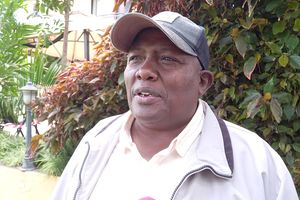Premium
More than 2 million Kenyans on the brink of starvation, study reveals
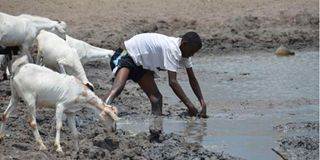
A man draws water for his goats in Ijara , Garissa County
At least two million Kenyans are on the brink of starvation and are in dire need of food aid, a report has said.A study by World Vision East Africa Hunger Emergency Response says the worst-hit counties are Garissa, Wajir, Mandera, Isiolo, Samburu, Turkana and North Horr, Laisamis Sub counties in Marsabit County as well as Tiaty in Baringo, with severe effects of malnutrition being recorded since August last year.“It is estimated that currently in Kenya, two million people are in acute food insecurity and need emergency relief support. The main reason for the high levels of acute malnutrition is largely attributed to reduced milk production and consumption among children,” the report released this week says.The situation, the report says, is almost similar to what’s facing neighbouring countries of Ethiopia, Somalia, South Sudan, Sudan and Uganda.
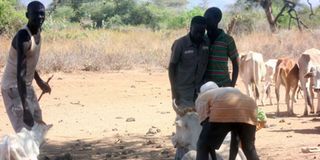
Residents of Barwessa in Baringo County lift an emaciated cow drought on January 8, 2017.
“A deadly mix of conflict, Covid-19 and the climate crisis have pushed more than 7 million people across six countries in East Africa to the very edge of starvation,” the report adds.According to a different drought report by the United Nations, approximately 108,000 people in East Africa are under catastrophic famine conditions which have sparked acute malnutrition, starvation and deaths.More than 7.8 million people are also exposed to the emergency phase and will be adversely affected by famine if interventions are not made to remedy the situation.“Between June and December 2020 rising conflicts in countries such as Ethiopia worsened the food insecurity situation, coupled with economic impact of lockdown which affected livelihoods and pushed millions to desperation,” read the UN’s report.In Baringo, some of the worst hit villages in Baringo North, South and Tiaty constituencies are Yatya, Chepkesin,Ng’aratuko, Kagir, Chemoe, Kamwetio, Mbechot, Kasieala,Arabal, Chemorong’ion, Mukutani,Noosukro, Kapau, Gulal, Chesawach, Akoret, Ameyan, Katikit, Lokis, Ng’aina, Chesotim, Nasorot, Natan, Riong’o, Chesawach, Akwichatis and Naudo and parts of Mogotio.Harsh weatherLocals in the affected villages claimed that they are on the verge of starvation and some families are going without food for days, a situation they said might escalate if no action is urgently taken by the government.Akuro Kalale from Tirioko in Tiaty Sub-County said many locals are at risk of dying of hunger as the number of people in need of food has hit the ceiling following harsh weather.
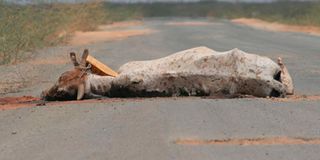
A carcass of a cow on the Hola - Garissa road.
“Several people, especially the aging, children and women are helpless and most of them have been left alone in their houses as the able members of the families look for water and pasture and the situation may escalate if no action is urgently done to save the situation,” said Kalale.Lactating mothers have borne the biggest brunt of the hunger pangs as their breasts cannot produce any milk to suckle their young ones having not eaten for days.“Children here survive on one meal a day if at all they will be lucky to get. I no longer breastfeed my five months old baby because I go without food for days and my other children depend on porridge,” said Ms Chepochot Lokwe from Kapau.It also emerged that some residents have started feasting on carcasses of dead livestock sparking fears of diseases.Mr Paul Kipyemat from the banditry prone Arabal claimed that the scarcity of food has also been worsened because they cannot fend for themselves, including farming for fear of armed criminals suspected to be from the neighbouring community who are hiding in their village.
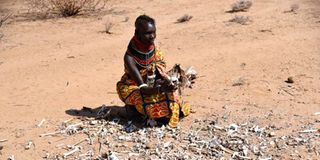
Arupe Amoja Edonga a resident of Lorukia village in Kalapata Ward, Turkana County shows bones of goats on March 23, 2019.
“The situation here is so bad. We have been abandoned and we are left wondering if we are any lesser Kenyan. We have no food to eat and we cannot also go out to fend for fear of being ambushed and shot by bandits. We have virtually been reduced to beggars,” said Mr Kipyemat.Livestock keepingTiaty residents, who rely on livestock keeping, have also complained that the closure of all livestock markets has led to lack of cash to buy food. Baringo Deputy Governor Jacob Chepkwony said that food security in the region has been worsened by the effects of Covid-19 pandemic.“The dry spell and the effects of the pandemic have contributed to food insecurity in this region. We are appealing for assistance from the national government,” said Mr Chepkwony.Tirioko Ward Representative Sam Lourien said that more than 5,000 residents in his locality have moved to the neighbouring West Pokot County in search of water and food.“Locals in the worst hit Kapau, Kongor and Lokis have crossed to Sigor, Lomut and Mosul areas in West Pokot in search of food and water. Without sufficient food, young children are at a greater risk of malnutrition,” said Mr Lourien. He appealed to the National Drought Management Authority and other concerned authorities to move with speed and assess the situation and initiate mitigation efforts in areas like Kapau, Kongor, Gulal, Natan, Riong’o and Akoret.Farmers in the area who rely on irrigation, have complained that water levels in the seasonal rivers have drastically dropped due to drought.Crops have started withering at Murda, Nenteyo, Lebunyaki, Lorrok, Sandai, Mosuro, Eldume, Kamosok and Sukutek irrigation schemes.Perkerra Irrigation Scheme has been a lifeline to more than 13,000 people. However, the dry spell being experienced in the area is threatening the existence of the 5,800-acre scheme with more than 1,800 acres of maize plantation.The irrigation Scheme depends on the Perkerra River, the only permanent river in the sub-county that is almost drying up due to drought.The more than 5,800 Perkerra Irrigation Scheme in Baringo County has been a lifeline to more than 13,000 people with more than Sh100 million being generated annually.In 2018, for instance, farmers planted 2,200 acres of seed maize for Kenya Seed Company and Monsato on contract at a negotiated price of Sh66 per kg. The farmers delivered a total of 2,652 tonnes of clean seed maize which fetched more than Sh175 million.Due to perennial water shortage, only 2,000 acres has been developed for furrow irrigation and 1,500 is being cropped.[email protected]


